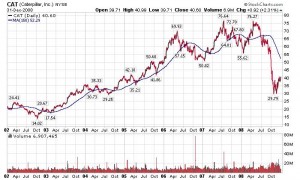The chart of Caterpillar (CAT) stock from 2002 to 2008 is an example of a cyclical stock that people became enthusiastic about and then subsequently sold in a panic. Notice how the stock steadily rose from the end of 2002 to the beginning of 2008 and then gave up a substantial portion of those gains in less than a few months. People generally feel twice as much sadness or pain when something is lost than when something of equal value is gained. Humans have evolved to be this way, because when the world was more resource constrained, our ancestors’ survival depended much more on keeping what they had than getting something new. The emotions that arise from loss are from parts of the brain that evolved much earlier than the parts responsible for rational thought. This is the main reason why stocks go down faster than they go up. People tend to get depressed and want to capitulate much faster than the time it takes for them to get euphoric. Furthermore, as a stock rises, many people quickly sell to lock-in their gains. The shareholder base gradually transitions from distressed and value investors, who contest momentum, to growth investors, who typically invest hoping to ride a trend. When a stock goes down and its momentum shifts, the only people that would be interested are the distressed or value investors. Since these types of investors tend to be less impulsive and generally more risk averse, they are usually slow to accumulate shares. After all, they know that betting against a current trend often results in initial losses. Distressed or value investors are in no rush to build fully-sized positions.
The above is an excerpt from my book: The Emotionally Intelligent Investor: How Self-Awareness, Empathy and Intuition Drive Performance
